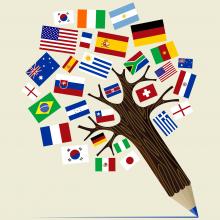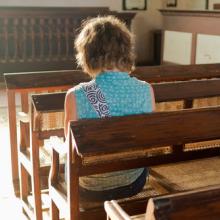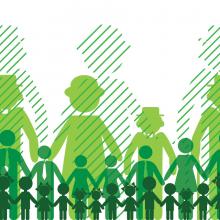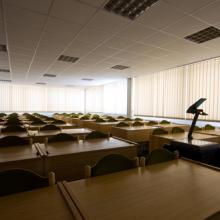Schools
Pope Francis on Monday made good on a promise to apologize to Canada’s native people on their home land for the Church’s role in schools where Indigenous children were abused, branding forced cultural assimilation “evil” and a “disastrous error.”

A crew performs a ground-penetrating radar search of a field, where the Cowessess First Nation said they had found 751 unmarked graves, near the former Marieval Indian Residential School in Grayson, Saskatchewan, Canada on June 18, 2021. Federation of Sovereign Indigenous Nations/Handout via REUTERS.
“I have spoken personally directly with His Holiness Pope Francis to press upon him how important it is not just that he makes an apology but that he makes an apology to indigenous Canadians on Canadian soil,” Trudeau told reporters in Ottawa.
As far back as the early 19th century, Catholic students and other religious groups were sometimes whipped, beaten, and worse, for not participating in prayer and Bible reading in the common schools, a predecessor to the public schools.

Image via Fotosr52/Shutterstock.com
Humanists went to federal court in Denver to prevent Colorado schoolchildren from being asked to put together Christmas gift boxes sponsored by an evangelical charity.
The hearing on Nov. 16 was the result of a suit filed by the American Humanist Association, a national organization of humanists, atheists, and freethinkers. They are representing three humanist families who say the constitution’s guarantee of the separation of church and state is violated when their suburban Denver school district asks their children to assemble Christmas gift boxes that include the “opportunity . . . to faithfully follow Jesus Christ.”
We write to you on All Saints Day to update you on the situation in Iraq. Remembering the Christians who were killed in 2009 while attending Mass at Our Lady of Deliverance Church in Baghdad. That was the beginning of harder times to all Christians in Iraq.
It has been two years and four months since we left Nineveh Plain. It has been long time of displacement, of humiliation, of exile. However, people always lived in hope of God’s mercy to return and go back home. We believed that God will not fail us.
Each day, children on their way to Mount Carmel School pass through gates under the watch of armed security guards, and now city police officers who stop there on government orders after a nearby Catholic convent and school were broken into.
The vandals stole money, tampered with security cameras, and ransacked the principal’s office on Feb. 13.
The crime itself was relatively minor, but it rippled through other Christian schools. The attack was the sixth this year in an ongoing series targeting Christian communities and schools across India.
HILDA DE BOJORQUEZ holds a set of blueprints in one hand. Her other hand is pointing. At a better future, perhaps, if things go well.
De Bojorquez is the chief engineer at this construction site in a neighborhood just outside Port-au-Prince still blemished with rubble from Haiti’s 2010 earthquake. She commands respect from the all-male crew of Haitians working at the site—she tells a group of visiting U.S. reporters that her gender has never been an issue in the male-dominated world of construction, here or in her native El Salvador.
When asked about obstacles on the project, De Bojorquez goes on for 15 minutes—she’s an engineer, after all—but the point is that they’ve tackled them, one by one, and done so the right way. She extols the importance of a solid foundation and robust retaining walls. She points to the cinder blocks and the rebar, and explains how her group had to teach a company how to provide high-quality materials, with the promise that they’d buy everything the company made. And she emphasizes that she’s there not just to oversee a number of construction projects, but to train Haitians to do it themselves the next time—and to do it right.
The steel-reinforced blocks are rising into walls that will surround a new six-room school for perhaps 200 children in this neighborhood four miles east of Port-au-Prince. The narrow site is wedged between two crumbling buildings, both showing earthquake damage. Even to an untrained eye, the differences are obvious between the fragile, deteriorating blocks next door and the solid retaining walls rising at our feet.
People of faith can play an important role in helping each child of God realize his/her potential. Join us in standing up for education by signing the #UpForSchool petition, an urgent appeal to get every child into school—no matter who they are or where they are born.
When we invest in schooling for all children, lives are transformed for generations to come. For example, closing the education gap for girls reduces child marriage rates, leads to more income later in life, and lowers the rate of HIV/AIDs. Access to equal education is not only essential to building stronger economies and a healthy society, but it honors the God-given dignity of children.
My mom would agree: education is empowerment. It provides freedom and a better future—and no child in the world should be denied it.
Let us all pray that every child can go to school.
And let’s join other faith communities to make sure it happens—sign the petition now.
SIXTY YEARS AGO, Brown vs. Board of Education held that it was unconstitutional to have separate public schools for black and white students. Fifty years ago, a landmark piece of U.S. civil rights legislation was enacted that outlawed discrimination based on race, color, religion, sex, or national origin. By design it was to end, among other important things, educational racial inequities by eliminating separate educational experiences based on race.
Yet today, no matter how we view the data, children of color, especially African-American boys, show unequal levels of achievement—well below their white classmates. Data from the National Association for Educational Progress (NAEP) shows 38 years of limited-to-no change in rates of achievement for African-American and Latino children. Schools across the country are still distinctly segregated by race, and the willful interest and resolve to lead on these issues remains sluggish.
Overcoming systemic racial achievement disparities among children in our public schools is an overarching moral imperative of our day.
How is it that we cannot collectively rupture this trajectory—more than half a century later—“with all deliberate speed”? As an educational leader I find myself focused on these questions: Are those invested in educating our children interested enough? Do we actually know how to educate all students equitably? Where is the resolve among us to make lasting change for all children? I believe that, if we are interested, we’ll learn. And that once we know how, we can change this narrative—but only if we are resolved to insist on positive change no matter the cost.
1. Awakening:
It is impossible to build a transformative movement for justice if people remain in the dark about the magnitude of the crisis at hand, its origins, and its racial, economic, and political dimensions. I wrote The New Jim Crowbecause I strongly suspected that most people simply had no idea what was really going on and that education was a necessary prerequisite to effective action. I still believe that’s the case, and so urging people of faith and conscience to commit themselves to raising the consciousness of their congregations and communities is extremely important.
Encourage people to hold study groups, film screenings, public forums, and dialogues to help others awaken to what has happened on our watch and become motivated to join the movement. The Unitarian Universalists, the Samuel DeWitt Proctor Conference, Veterans of Hope, and PICO are all engaged in consciousness-raising work and have created study guides based on The New Jim Crow and other resources.
2. Building an Underground Railroad:
Obviously, consciousness-raising is not enough—we will have to get to work. In my view, that necessarily involves building an “underground railroad” for people trying to make a break for true freedom in the era of mass incarceration and who desperately need help finding shelter, food, work, and reunification with their families.
RECENTLY, the U.S. celebrated the 60th anniversary of the landmark Supreme Court case Brown vs. Board of Education that declared unconstitutional state laws establishing separate public schools for black and white students. By winning the Brown case, Thurgood Marshall broke the rock-hard foundation of racial barriers between black and white schools in the U.S.
But the civil right of equal opportunity for equal education never ensured the human right of equal access to it. Thus the explicitly racial divide, reinforced by law, was replaced by a close kin: the poverty divide, reinforced by economic blight entrenched by white flight to the suburbs.
Ten years later President Lyndon B. Johnson took a bulldozer to that new economic divide by declaring, in his January 1964 State of the Union address, an unconditional “War on Poverty.” He said, “Let this session of Congress be known as the session which did more for civil rights than the last hundred sessions combined.” And it did.
EVERY WAR HAS multiple fronts. Johnson’s fight against poverty was a legislative one, which played out in states, cities, and school districts across the country. Within two years Congress had passed the Civil Rights Act, the Food Stamp Act, the Economic Opportunity Act, and the Social Security Act. Each act was a legislative beachhead in the assault against U.S. poverty.
The Elementary and Secondary Education Act of 1965 represented a major shift in the way the U.S. conceived public education. In this act, Johnson took direct aim at the economic infrastructure that barred blacks and other impoverished people from accessing equal education.
THIS IS NOT a column full of hand-wringing about the moral decay of U.S. society. Nor is it about my concern for the souls of my fellow citizens who are atheists, agnostics, or some other stripe of nonbeliever. I am worried about the growing number of religious “nones” in the United States, but not for those two reasons.
Let me be clear about something before continuing: Many of the people I love and admire most are religious “nones”—those who indicate “none of the above” on religious preference surveys. They include people of high intellect, great sensitivity, and deep character. In fact, many of them could give lessons in such areas to some of the religious people I know.
What they do not do is build hospitals, schools, colleges, or large social service agencies. Such institutions (when not built by the government) have generally been founded and supported by religious communities in the United States. This is not so much because religious people are always better human beings; it’s because religious communities value and organize such work at significant scale.
Religious communities play a profound role in U.S. civil society. About one out of every six patients in the U.S. is treated by Catholic hospitals. Most, if not all, have some sort of explicit commitment to serving the poor because of their faith identity. There are nearly 7,000 Catholic grade schools and high schools in the U.S., and more than 260 colleges. This is to say nothing of the refugee resettlement, the addictions counseling, or the services for homeless men and battered women provided by Catholic social service agencies.
In my lifetime I’ve driven on three roadways named after Martin Luther King, Jr. One was a street, another a boulevard, and the third a highway. And whether by cosmic irony or human design, each of these roadways passes through communities of significant poverty and color, namely black. Around these roadways are boarded up storefronts, crack and heroin dens (think The Wire), condemned row houses, and inevitably, always – public schools.
From 2001 to 2006 I left the safety of the pulpit to teach in the schools of Baltimore and Washington, D.C., pursuing a call to care for the proverbial least of these (it’s always pained me to think how I might feel to be called this, as in hey, you least of these, can I help you with anything? – but that’s a reflection for another time). I left also the safety of a suburban megachurch, where all you needed to do to understand the socioeconomic standing of its members was to walk through the parking lot, and the familiar cultural context of my Korean-American upbringing.
This article, however, is not about me. It’s about beautiful, creative, energetic, and intelligent children — kids who, as the least of these, are too often treated as such. There is no limit to blame: from the mother who comes to school drunk, a prostitute, publically shaming her son (who loves her nonetheless and gets beaten by the other boys defending her honor); to the worn-out teacher who drags a “difficult” child into the bathroom, bruising her arms and threatening her with verbal vitriol and rage; to the administration that promotes student after student, knowing they are years behind, but too old to remain; to the system that maintains, protects, and worships a biblical truism, that for to all those who have, more will be given, and they will have an abundance; but from those who have nothing, even what they have will be taken away (Mt.25:29).
I love October. As a teacher, it was that time of year where rhythms were becoming established and the seeds of learning were beginning to sprout. In ministry, it is the time where I find myself riding the waves of my student’s school schedules in an effort to connect and converse. In either case, education, shapes not on the schedule of my life but the purpose.
As I breathe in the crisp autumn breeze, it reminds me to consider the larger partnership between the educators and the church. When we, as ministers and church leaders, consider what role education plays in the life of the church, we have to consider the active part of the church in the education of not only the church community, but its larger context.
Education, in the public context, is a constant topic of political struggle and strife. Education, in the ecclesial context, in its best is in-depth Bible study and at its worst is education by osmosis and observation. What is the call or consideration of the church to the topic of education? What role does the church have in the education of the community?
Leading secularists are calling on nonreligious parents to fight a government effort that would allow the Church of England to run thousands of state schools.
The schools, or academies, would be privately funded, quasi-independent and accountable to the church for their curricula, organization, admission policies, and teachers’ pay and conditions.
As of July, there were 3,049 such academies operating in England, many financed by businessmen, finance companies, supermarkets, football clubs, and a growing number of faith-based organizations including the Roman Catholic Church, the Methodist Church and the largest of all — the Church of England.
IN AMERICA, WE honor the ideal of equality and the myth of equal opportunity—but the secret we refuse to acknowledge is the debilitating, dehumanizing effects of poverty. As a pastor serving the South Side of Chicago, I witness firsthand the pain that poverty inflicts upon our congregation and the scars it leaves on the most vulnerable: children. Faith in Christ should mean a commitment to the poor.
There is a growing wealth gap between African-American households and white households. A Pew research study, for example, shows the dramatic change between 2005 and 2009. In 2005, the typical white household had a net worth of $134,992 (in 2009 dollars), while the typical black household had a net worth of $12,124—9 cents for each dollar the white household owned. By 2009, that fell to 5 cents, as the typical black household saw its net worth drop more than 53 percent, as compared to a drop of 16 percent for the average white household. And, alarmingly, 35 percent of black households in 2009 had a zero or negative net worth.
A few seek to blame this damaging downward trend on the current administration's policies. This is unfair and incorrect. Black families have traditionally built wealth through homeownership, but since the mid-1990s we have witnessed a dramatic increase in bank mergers—and predatory lending. Local banks, now owned by large corporate institutions with little interest in community investment, increasingly close branches in poor communities, then check-cashing establishments fill the void in financial services. At the same time, our nation faces the loss of manufacturing and the dismantling of organized labor. The triple threat of regressive economic policy, unchecked expansion of large, unaccountable financial institutions, and the economic crisis of 2008 devastated parts of cities across the nation: Chicago, Cleveland, Detroit, Atlanta, New York, Buffalo, Flint, and many others.
As the Faith Based Organizer for the Federation of Protestant Welfare Agencies (FPWA) — a citywide coalition of more than 300 member agencies and faith institutions — I have the privilege of working with a diverse group of faith leaders. Last spring we were thrust into an important struggle for childcare and after school funding led by the Campaign for Children (C4C), a citywide coalition of organizations advocating for childcare and after school funding. Some may wonder why clergy would be concerned about this issue, but for the clergy I work with, the reason is clear: budgets are moral documents, and what is funded reflects our values. Our clergy know that children are the greatest in God’s kingdom and our investment (or lack thereof) in them will have consequences for our future.
In New York City obtaining quality education is a serious struggle for parents of all classes. This struggle includes waiting lists that upperclass parents place their unborn children on, intelligence test for 5 year olds, interviews and hustling from one open house to another. Finding childcare is a daunting task, especially for low-income parents. As a child in New York City I knew how important it was to not end up at my “zone school,” which are schools for children who could not get in anywhere else. Growing up in one of the 12 poorest communities in New York City, my zone schools were the worst. From junior high on I had to take buses and trains to get an education. The process of finding childcare is one of the clearest depictions of the greatest lie that controls New York City: “that some people are worth more than others” (NYFJ Faith Rooted Organizing Core Lie Exercise March 2011).
I love to receive letters. When I was a little boy, I lived on a long, straight street and I could see the mail truck coming from a long way off. After the mailman stopped in front of our house, I ran with hope in my heart down our front walkway, between our two giant maple trees and across the street to our mailbox. Would there be a letter for me? Was someone in the world thinking of me?
One day last year it was not the mailman, but a second-grader on the school playground, who handed a letter to me. I unfolded it.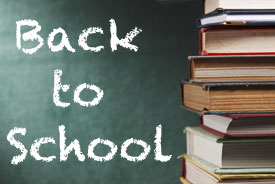
"Dear Mr. Barton, hi it Odeth from 2th grade I miss you a lot I wanted to know about you so much I am being good I am in 4th grade Do you miss me. I live in __________ I go to school in __________ I hope you will come to my school … can you come visit me in school ask for my name…I am 10 year old I want you to come to my school.
Your best student,
Odeth"
What a wonderful thing, to be remembered by a student.
Editor's Note: Over the next two weeks, Sojourners is celebrating our teachers, parents, and mentors as children across the country head back to school. We'll offer a series of reflections on different aspects of education in our country.
My elementary school is a Title I school. About 97 percent of our students qualify for free and reduced lunch and Medicaid. Research shows us that many children raised in poverty struggle to learn to read. 
Common sense tells us that children who don't learn to read can't read to learn. They often reach a frustration level with school by the time they're in the third grade. According to the U.S. Department of Education, 70 percent of low-income fourth-grade students can't read at a basic level. I often wonder, "What can I do in my day-to-day work as a teacher to help?"





